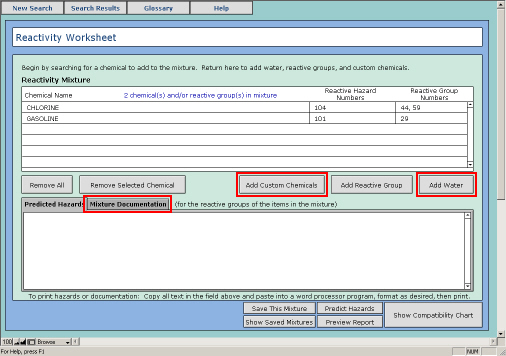|
Chemical Reactivity Worksheet (CRW)
The Chemical Reactivity Worksheet (CRW) is a free program you can use to find out about the reactivity of substances or mixtures of substances (reactivity is the tendency of substances to undergo chemical change).
It includes:
- a database of reactivity information for more than 5,000 common hazardous chemicals;
- a way for you to virtually "mix" chemicals--like the chemicals in the derailed tank cars above--to find out what dangers could arise from accidental mixing.
The database includes information about the intrinsic hazards of each chemical and about whether a chemical reacts with air, water, or other materials. It also includes case histories on specific chemical incidents, with references.
Version 2.0 of the Chemical Reactivity Worksheet (CRW 2.0) was released on February 19, 2009, and includes the new features described below. Subsequent to the release of CRW 2.0, two versions were released:
- CRW 2.0.1 Released as a result of changes to the CRW's internal chemical database. Previously, there were 191 records in the chemical database that contained significant amounts of water, as aqueous solutions or mixtures such as explosives wetted with water to desensitize these materials. When assessing the chemical reactivity, we neglected to include the water portion of the mixture. These records are now consistent with the rest of the compatibility requirements for other materials in the database.
- CRW 2.0.2 Created to fix a major bug in the "Custom Chemical" feature of the CRW. Version 2.0.1 didn't allow the user to add new chemicals.
Please download the new version, CRW 2.0.2, and discard earlier versions. Below is an important note for those who have already added custom chemicals to CRW 2.0.
NOTE: If you have created a database of custom chemicals in CRW 2.0, installing CRW 2.0.2 will erase your database. Before installing CRW 2.0.2, please contact the CRW Specialist (phone: 206-526-6322) to help you preserve your data.
New Features of the CRW
- CRW 2.0 has a new FileMaker Runtime user interface, which makes it compatible with the latest computer operating systems.
- Because some facilities store custom or proprietary chemicals that are not included in the CRW's chemical database, CRW 2.0 allows you to build a "Custom Chemical Database" containing all the materials that are present at your particular facility. This allows you to create records containing pertinent reactive hazard information for those chemicals. In addition, you can update the CRW's standard chemical database without affecting your custom chemical data.
- For any given mixture for which gases are predicted, CRW 2.0 presents the potential gaseous products, along with literature citations for those gases.
- For many of the predicted hazards, full literature citations are provided. The documentation is presented as a brief summary, with the citation for those who want to read the full description of the reported reaction.
- Water has been added to the CRW 2.0 available substances, and can be added to any chemical mixture by clicking a button on the Reactivity Worksheet window.
 | | Click the Add Custom Chemicals button to add custom or proprietary chemicals to the CRW. Click the Mixture Documentation tab to view literature citations for the reactive group pairs in the mixture. Click the Add Water button to add water to a mixture and see general predictions about how the chemicals in the mixture would react with water. |
All versions of the CRW were developed by the Chemical Reactivity Team at the Office of Response and Restoration (OR&R), National Ocean Service, NOAA, in collaboration with the Environmental Protection Agency (EPA) and the Center for Chemical Process Safety (CCPS).
|


